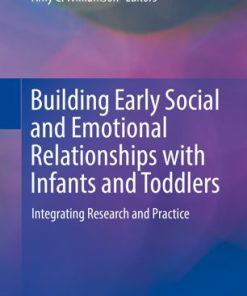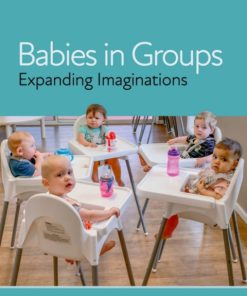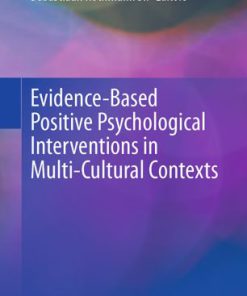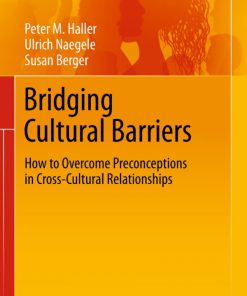Studying Babies and Toddlers Relationships in Cultural Contexts 1st Edition by Liang Li 9811031977 9789811031977
$50.00 Original price was: $50.00.$25.00Current price is: $25.00.
Studying Babies and Toddlers Relationships in Cultural Contexts 1st Edition by Liang Li – Ebook PDF Instant Download/DeliveryISBN: 9811031977, 9789811031977
Full download Studying Babies and Toddlers Relationships in Cultural Contexts 1st Edition after payment.
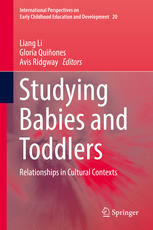
Product details:
ISBN-10 : 9811031977
ISBN-13 : 9789811031977
Author: Liang Li
The editors of this book have brought together contributors from many parts of the world. As such, the book offers a truly diverse, international flavour reflecting a broad range of research on babies and toddlers. Examining examples from both Eastern and Western cultures, the book’s overarching focus is on relationships, yielding a coherence beneficial to early childhood researchers and educators alike. Employing visual methodologies to help bring the chapters to life, the varied research studies presented concern babies’ and toddlers’ relationships and cultural contexts. Taken together, they offer a unique opportunity to conceptualise the use of a wholeness approach for studying babies and toddlers – our youngest citizens.
Studying Babies and Toddlers Relationships in Cultural Contexts 1st Table of contents:
Chapter 1: A Wholeness Approach to Babies’ and Toddlers’ Learning and Development
1.1 Introduction: Wholeness Approach for Creating Coherence
1.2 Valuing Relationships
1.3 Dynamic Dialectics
1.4 Complex Cultural Worlds
1.5 A Wholeness Approach to Study Young Children’s Cultural Worlds and Transitions
1.5.1 Societal Perspective
1.5.1.1 Institutional Perspective
1.5.1.2 Individual Perspective
1.6 The Babies’ Relations to the World
1.7 Researching the Babies’ World
1.8 Conclusion
References
Chapter 2: Toddler’s Relationships: A Matter of Sharing Worlds
2.1 Introduction
2.2 The Life-World
2.3 Shared Life-Worlds: Worthy to Be Defended
2.3.1 Creating Shared Life-Worlds
2.3.2 Shared Life-Worlds: Defence and Threats
2.4 Shared Life-Worlds: Sympathy
2.5 Shared Life-Worlds: Difference and Similarity
2.6 Shared Life-Worlds: Part of Young Children’s Very Existence
References
Chapter 3: The Babies’ Perspective: Emotional Experience of Their Creative Acts
3.1 Introduction
3.2 Perezhivanie: The Babies’ Emotional Experience
3.3 A Dialogue Commentary: Visual Narrative Methodology to Explain Babies’ Emotional Experience
3.4 Analysis of Case Examples
3.4.1 Case Example 1: Luci’s Moon Up High
3.4.2 Luci’s Social Dynamic Music Environment Setting
3.4.3 Affective Moments and Relations in ‘Moon Up High’
3.4.4 The Music Reciprocity
3.4.5 Case Example 2: Elvin’s ‘If You Are Happy…’
3.4.6 The Social Environment and Situation of Elvin’s Awareness of the Song
3.4.7 Affective Movements to the Favourite Song
3.4.8 The Art of Reciprocity
3.4.9 Case Example 3: Silvana’s Drum Dance
3.4.10 Silvana’s Music and Dance in Daily Life Moments
3.4.11 Affective Engagement with the Drum Dance
3.4.12 The Reciprocity of Dance
3.5 Discussion
3.5.1 Babies’ Creative Acts Are Culturally Constructed
3.5.2 Babies’ Perezhivanie in the Creative Acts
3.5.3 Taking Babies’ Perspective to Provide Reciprocal Emotional Support During the Transitory
3.6 Conclusion
References
Chapter 4: Spatial Perspective on Everyday Transitions Within a Toddler Group Care Setting
4.1 Introduction
4.2 Henri Lefebvre’s Spatial Approach
4.3 Ethnographic Fieldwork for the Empirical Case
4.4 Circle Time
4.5 Lunch Time
4.6 Discussion: Constructed and Lived-Through Transitions
References
Chapter 5: New Mothers Transitioning to Employment: Impact on Infant Feeding Practices
5.1 Introduction
5.2 Background
5.2.1 Infant/Mother Dyad
5.2.1.1 Infant Feeding Practices
5.2.2 Mother’s Transition to Work
5.2.3 Infant’s Transition to Childcare
5.3 The Study
5.3.1 Theoretical Framework
5.3.2 The Individual as the Focus of Analysis
5.3.3 The Interpersonal Focus of Analysis
5.3.4 The Cultural-Institutional Focus of Analysis
5.3.5 The Research Method and Design
5.3.6 Aim
5.3.7 Sample
5.3.8 Data Generation
5.3.9 Data Analysis
5.4 Findings
5.4.1 Expectations
5.4.2 Choices
5.4.3 Tensions
5.5 Discussion
5.6 Implications, Challenges and Limitations
5.7 Conclusion
References
Chapter 6: Well-Being of Mothers and Young Children in Contexts of Special Health Care
6.1 Introduction
6.2 An Ecological Perspective
6.3 Research Sample
6.4 Method
6.5 Findings and Discussion
6.5.1 Child’s Cultural World with Special Health Issues
6.5.2 Well-Being Between Mothers and Young Children with Special Health-Care Needs
6.5.3 Quality of Relationships and Social Supports
6.5.4 Maternal Employment, Work Experiences and Financial Well-Being
6.6 Limitations
6.7 Implications of Findings for Future Research
6.8 Conclusion
References
Chapter 7: Family Child/Day Care Homes as a Cultural Context or World for Babies and Toddlers
7.1 Introduction
7.2 Eco-Cultural Theory
7.3 The Research Projects
7.4 Themes: Cultural Models and Ideas About Children’s Ages
7.4.1 Cultural Models
7.4.2 Children’s Ages and Cultural Models
7.5 Conclusion
References
Chapter 8: Intergenerational Conflicts and Transmission of Values in Raising 0–2-Year-Old Chine
8.1 Introduction
8.2 Theoretical Framework
8.3 Research Design
8.3.1 Method
8.3.2 Participants
8.3.3 Data Analysis
8.4 Findings
8.4.1 Cooperating with Each Other: Grandparents Respect Parents’ Authority
8.4.2 Parents Hold the Authority: Parents Stand at the Family Core, While Grandparents Give Up T
8.4.3 Compete for Raising Authority: Parents Stand at the Family Core and Grandparents Seeking F
8.4.4 Avoid Baby-Raising Responsibility: Grandparents Live Independently and Refuse to Take Raisin
8.4.5 Grandparents Hold the Authority: Grandparents Stand at the Family Core and Parents Live in
8.5 Discussion
8.5.1 The Person Holding Authority Has the Power to Define the Boundaries and Identity Standards
8.5.2 Social Structure Influences the Status and Authority of the Two Generations in Family
8.5.3 The Inequality in Transmission of Values
8.6 Conclusion
References
Chapter 9: The ‘Work of the Eye’ in Infant Research: A Visual Encounter
9.1 Introduction
9.2 The Rapid Rise of Visuality
9.3 The Invisibility of the Visual in Infant Research
9.4 Invoking the Eye(s)
9.5 Encountering the ‘I’ Subjectivities as an Effort of Trying
9.6 Analysing Language and Its Meanings
9.7 The Language of the Eye
9.8 A Concluding Proposition for Infant Research (and Practice)
References
Chapter 10: Examining the Dynamics of Infant Reciprocity and Affective Fatherhood
10.1 Introduction: Dynamics of Interaction
10.2 Building a Fence: Jorge and Silvana, Case Example 1
10.2.1 Visual Narrative
10.2.2 Dialogue Commentary
10.3 Elvin’s Kitchen Play with Dad: Case Example 2
10.3.1 Visual Narrative
10.3.2 Dialogue Commentary
10.4 Playing with Sound: ‘Hi Luci’, Case Example 3
10.4.1 Visual Narrative
10.4.2 Dialogue Commentary
10.5 Discussion: Examining the Dynamics of Infant Reciprocity
10.5.1 Balancing Playful Intentions
10.5.2 Cultural Learning Through Reciprocity
10.5.3 Dynamic Relationships
10.6 Conclusion
10.6.1 A Relational Ontology
References
Chapter 11: Applying the Tavistock Method of Observation and Group Reflection to the Study of
11.1 Introduction
11.2 Key Theoretical Concepts Underpinning the Tavistock Method
11.2.1 Countertransference
11.2.2 Projective Identification
11.2.3 Container/Contained
11.3 Applying the Tavistock Observation Method to Childcare Settings
11.4 Case Study 1: Tuan Aged 18 Months – Countertransference
11.4.1 First Observation
11.4.2 Seminar Discussion: My Introduction to Countertransference
11.4.3 Second Observation
11.4.4 Third Observation
11.5 Case Study 2: Estelle Aged 42 Months – Projective Identification
11.5.1 First Observation
11.5.2 Seminar Discussion. How Projective Identification Was Experienced
11.5.3 Observation 2
11.5.4 Observation 3
11.6 Case Study 3: Donald Aged 12 Months – Container/Contained
11.6.1 First Observation
11.6.2 Second Observation
11.6.3 Third Observation
11.6.4 Post-observation
11.6.5 Seminar Discussion: How Containment Was Experienced
11.6.6 Final Observation
11.7 Commentary
11.8 Concluding Thoughts
References
Chapter 12: Transitory Moments as “Affective Moments of Action” in Toddler Play
12.1 Introduction
12.2 Cultural–Historical Theory
12.3 Methodology
12.4 Research Context
12.5 Case Example
12.6 Discussion
12.7 Conclusion
References
Chapter 13: Relations of Dynamic Aspects of Motives in Infant-Toddler’s Play: Enhance Small Sci
13.1 Introduction
13.2 Cultural-Historical Theorisation of Motives in Play and Learning
13.3 Study Design
13.3.1 Data Collection
13.3.2 Data Analysis
13.4 Findings
13.4.1 Background of the Play Settings
13.4.2 The Vignette: Explore Sound Concepts Through Multiple Toys
13.4.2.1 Part One: Explore Tiger’s Roar Sound
13.4.2.2 Interpretation of Part One
13.4.3 Part Two: Explore Whistle’s Sound, Rattle’s Sound and Drum’s Sound
13.4.3.1 Interpretation of Part Two
13.5 Discussions
13.5.1 Cultural Relations: Dynamic Aspects of Motives in Play
13.5.1.1 The Collective Play Situation as an Activity Setting – Development of Play Motives
13.5.1.2 Family as an Institution Creates the Relations to Motivate the Child
13.5.1.3 Culture of Family Play as a Societal Demand
13.5.1.4 Human Biology as Primary Motives
13.5.1.5 Relations with People Motivate the Child
13.5.1.6 Small Science Learning Through Dynamic Aspects of Play Motives
13.6 Conclusion
References
Chapter 14: Emotional Security and Play Engagement of Young Children in Dutch Child Centres: A S
14.1 Introduction
14.2 Emotional Security in Group Settings
14.3 Exploration of Quantitative Relationships
14.3.1 Level of Play Engagement
14.3.2 Factors in the Social and Material Environment
14.4 Main Quantitative Findings
14.5 Coherent Patterns of Behaviour at Group Level
14.5.1 Children Walking In and Out and Educators Disturbing Play
14.5.2 Quietly Nearby Educator and Undisturbed Play
14.5.3 Playing with Peers with the Educator Not Nearby
14.6 Friendly Intruders
14.7 Collaborative Studies with Practitioners to Verify Our Findings in Daily Practice
14.8 The Structured Pedagogical Experiment
14.8.1 The Findings
14.8.2 Three Interaction Styles of the Educator
14.9 Educators Testing the Hypotheses in Practice
14.9.1 Positive Experiences of the Educators
14.9.2 Problems in Introducing a New Pedagogical Approach
14.10 Conclusions and Discussion
14.10.1 The Complexity of Group Settings for Young Children
14.10.2 Availability
14.10.3 Follow the Pace of the Children and Not Disturb the Peer Audience
14.10.4 Quietly Confirming the Playing Children and Active Involvement
14.10.5 Significance of Testing of Hypotheses by Educators
People also search for Studying Babies and Toddlers Relationships in Cultural Contexts 1st:
relationship building infants toddlers and 2-year-olds
studying with a toddler
how relationships affect babies
do babies strengthen relationships
a curriculum based on relationships is simple basic and unexciting
Tags: Studying Babies, Toddlers Relationships, Cultural Contexts, Liang Li
You may also like…
Politics & Philosophy
Uncategorized
Uncategorized
Business & Economics
Politics & Philosophy
Politics & Philosophy - Sociology
History
Methods for Human History: Studying Social, Cultural, and Biological Evolution Patrick Manning
Computers - Programming
Learning Advanced Python by Studying Open Source Projects 1st Edition Li





